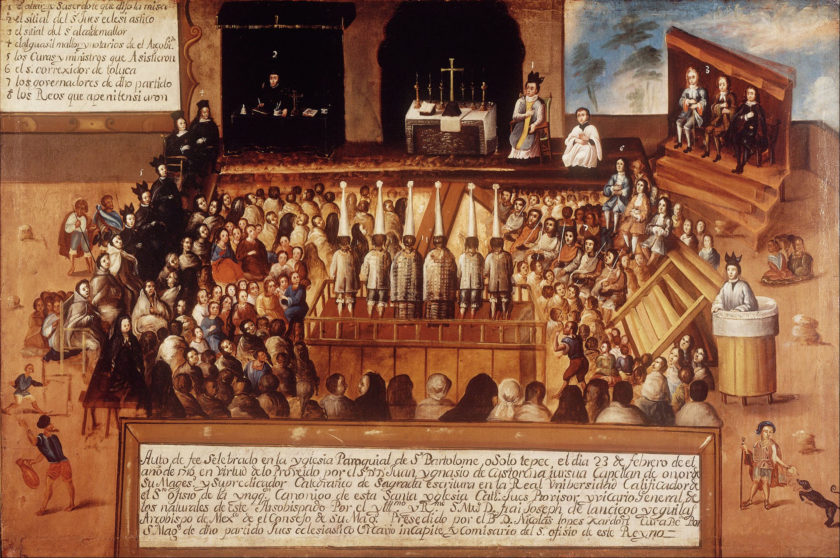The title above is of course a hat-tip to Monty Python. They rather famously did a series of comedy sketches that gave us the catchphrase, “Nobody expects the Spanish Inquisition!”. This posting is not about that. Instead, it is about a newly published paper that examines the long-term impact of religious persecution.
Study: The long-run effects of religious persecution: Evidence from the Spanish Inquisition
Published Aug 17, 2021 within the peer-reviewed journal, Proceedings of the National Academy of Sciences, the paper asks this fundamental question …
Can religious persecution have repercussions long after it has ceased?
To answer this question the researchers utilised data on the Spanish Inquisition to reveal how it impacts modern Spanish society.
What exactly did they do?
Starting with a dataset that contained the details of the 67,000 trials held by the Spanish Inquisition between 1478 and 1834, then then proceeded to combine that with modern-day survey data on trust and socioeconomic status, as well as information on income proxies and education.
What did they find?
Where the Inquisition made its presence felt more often or conducted more trials, economic activity is markedly lower today. Levels of trust and educational attainment are lower as well, while religiosity is higher.
But that’s just a correlation, what if those areas were already poor, less educated, and more religious?
Good question, but the following is also true. Using historical indicators of religiosity and wealth they show that the Inquisition did not focus its efforts on particularly poor or religious areas. Therefore, their results are not simply the product of economic backwardness or religious fervor persisting since the Middle Ages, the Spanish Inquisition does appear to have impacted specific areas in a way that ripples into modern society.
What was the Spanish Inquisition?
The Spanish Inquisition was established in 1478 and continued over many generations until as late as 1834. Its mission was to combat heresy. This was defined as anything that was not official Catholic doctrine. To achieve this they ended up persecuting tens of thousands of individuals over the course of its 356 year history.
Much of what they did was quite brutal and involved torture to get confessions that they could then convict with. Their idea of “mercy” was quite frankly repugnant. Those about to be burned alive might recant and change their minds. If this happened, then they were shown “mercy” by being garroted before their corpse was burned; if not, they were burned alive.
“Crimes” they targeted ranged from crypto-Judaism and Lutheranism to blasphemy and witchcraft. Its reach extended into almost every corner of Spain’s global empire and affected all strata of society, from simple peasants to kings themselves. Up to ten percent of those tried were clergy; one quarter were women.
You can read more about it on the Wikipedia page that covers the topic. That is a good primer to truly begin to understand how it operated.
Fear was also a very potent and powerful fallout. Like most repressive institutions, the Inquisition exerted a great deal of its influence through fear. Regular violence was not needed, just a few occasional trials was sufficient.
The intensity of persecution within Spain varied
It was not universal, some regions in Spain endured a rather large impact while others were passed over. The researchers have a map within their study that illustrates the impact distribution …
Southern tribunals saw a relatively higher intensity of persecution. Parts of the kingdom of Aragon, to the northeast of the map, also stand out as hot spots. The Inquisition’s arm even reached the most remote areas, including secluded valleys in the Pyrenees and most municipalities of the Balearic Islands.
About half of all municipalities in Spain have no recorded trials against their residents.
Why is there relationship between this Historic persecution and today?
Since the Inquisition was particularly suspicious of the educated, literate, and prosperous middle class, its impact on Spain’s cultural, scientific and intellectual climate was severe.
It banned the printing of forbidden books, and systematically targeted the richer and more educated parts of society. This reduced incentives to become educated, to work hard and become rich, and to think for oneself. Reactions to such religious pressure may well have become deeply ingrained into the local culture within the areas it impacted.
At first it is quite frankly a surprise to find that even today areas where the Inquisition persecuted more citizens are markedly poorer, more religious, and far less trusting. However, it does make sense. Social shocks at a critical juncture will have had a multi generational impact. High local conflict, low education and limited trust will inevitably lead to longer term negative outcomes. A social process that targeted the educated and the prosperous for over 350 years with a policy of totalitarian suppression is indeed going to ripple down the generations, and so perhaps this discovery should not be a surprise.
The Wider Global implications
While the scope of this study was just Spain, the inquisition operated on a far bigger stage. The paper finishes with this observation …
Our study has only examined the Spanish Inquisition’s effect in its heartland. However, the Inquisition also operated in Southern Italy and throughout Spanish America. Inquisitorial practices were also instituted throughout the Portuguese Empire and the Papal States. All of these areas today show relatively low education, lower incomes, and less generalized trust. Similar mechanisms to the ones documented in our study may well be at work in these places, affecting the lives of hundreds of millions to this day.
To finish as I started; in our modern world “Nobody expects the Spanish Inquisition!”, and yet here it is impacting lives even today.
